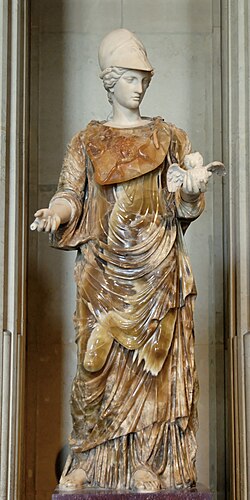Minerva
In Roman mythology, Minerva is the virgin goddess of wisdom, military strategy, warfare, civilization, science, navigation, justice, the state, education, medicine, commerce, the arts, victory, skill, heroes, strength, courage, industry, inventions, development, trades and peace, as well as being the protector of Rome and the patroness of artisans. She corresponds to Athena in Greek mythology, although initially the rank of warrior goddess is removed, being replaced by Bellona, the Roman goddess of war, who corresponds to Enio in Greek mythology. However, this change was not permanent since later in the history of Rome, Minerva would be renowned as a goddess of war, defense and strategy.
Titles and roles
The name "Minerva" was probably imported from the Etruscans, who called her Menrva. The Romans would have easily confused the foreign name for her with the Latin word mens, 'mind', since one of her aspects as a goddess corresponded not only to war, but also to intellect..
Myth
Minerva was the daughter of Jupiter, who after lying with Metis, Prudence, was a victim of terror, since she had been predicted that the children she would engender with her would surpass her in strength and wisdom, so she decided to swallow Minerva. Metis, to avoid said prophecy, however Metis was already pregnant and the fetus continued to develop inside the god. After a time, Jupiter began to feel a great headache and turned to Vulcan, who split his head open with an axe, from the split head sprang Minerva, now fully grown and fully armed, uttering a war cry so loud that it made that all the gods and the entire universe trembled with panic upon hearing it.
Jupiter, amazed and fearful of the figure he had conceived, made her a goddess of wisdom and strategic warfare, since he knew that Minerva had inherited her mother's intellect and her father's strength. In a few years she was able to help her father in the Gigantomachy (war against the Giants), where she distinguished herself by her bravery.
One of the most famous features of Minerva's story is her disagreement with Neptune to name the city of Athens after her. Twelve great gods, chosen as arbitrators, decided that whoever produced the most useful thing for the city would bestow its name. Neptune, with a stroke of his trident, caused the earth to produce an immense source of salt water. Minerva made an olive grove grow, and that was what gave her victory. As the patron goddess of Athens, great sacrifices were dedicated to her; thus, in the great Panatheneas (one of the most important festivals of the city), each tribe of Attica dedicated an ox to it, whose meat was then distributed among the people.
Sometimes she takes Ulysses on his travels, sometimes she deigns to teach the daughters of Pandora the art of standing out in the jobs that suit women, to represent flowers and battles in tapestry works, she is even the one who embellishes with her hands Juno's coat. She once faced Arachne to see which of the two she weaved faster. To prove it, she Minerva proposed a job: a magnificent fabric. When Minerva saw Arachne's superiority, she was so jealous that she decided to turn her into a spider (according to Ovid's account in The Metamorphoses ), a fact for which Minerva is known as a malevolent goddess. This scene was represented by Velázquez in his canvas Las hilanderas, currently in the Prado Museum (Madrid).
Finally, it is Minerva who has the ship of the Argonauts built according to her drawing, and who places on its prow the talking wood, cut in the forest of Dodona, which directed their course, informed them of the dangers and indicated to them the means of avoiding them. Under this metaphor it is easy to recognize the rudder of the ship.
Worship
Ovid called Minerva the "goddess of a thousand works." She was adored throughout Italy, though only in Rome did she take on a warlike character.
The Romans celebrated their festivities from March 19 to 23, during the day that was called, in the neuter plural, Quinquatria, it is the fifth day after the Ides of March, the nineteenth, the festival of craftsmen. A lesser version, the Minusculae Quinquatrus, was celebrated on the Ides of June, June 13, by the flute players, which were particularly useful for religion. Minerva was worshiped on the Capitoline Hill as part of the Capitoline Triad, along with Juno and Jupiter. In present-day Rome you can visit the Piazza della Minerva near the Pantheon.
In 207 B.C. C. a guild of poets and actors was formed to meet and make votive offerings in the temple of Minerva on the Aventine Hill. Among its members was Livio Andrónico. The Aventine sanctuary of Minerva remained an important center for the arts throughout most of the Middle Roman Republic.
In Plutarch's Life of Pericles, Minerva appears to Pericles in a dream and orders specific treatment for a wounded citizen of Athens. The treatment cured the man and a brass statue was erected in honor of the goddess.
He was also worshiped in many Spanish cities.
Representations
In her statues and images she is given a simple, careless, modest beauty, with a serious expression and impressive nobility, strength and majesty. He usually wears a helmet on his head, a pike in one hand, a shield in the other, and the aegis on his chest. She usually appears seated, but when she stands she has the resolute demeanor of a warrior, with a meditative air and gaze fixed on high conceptions.
Consecrated Animals
The animals sacred to Minerva were the owl, the bee and the dragon.. Sometimes, in reference to her cunning and the subtlety of her beauty, she was also linked to the snake, due to the sagacity that this animal represents.
Temples
- Capitol of Rome.
Contenido relacionado
Nemesis
Pandora
Archaeological site of Atapuerca

